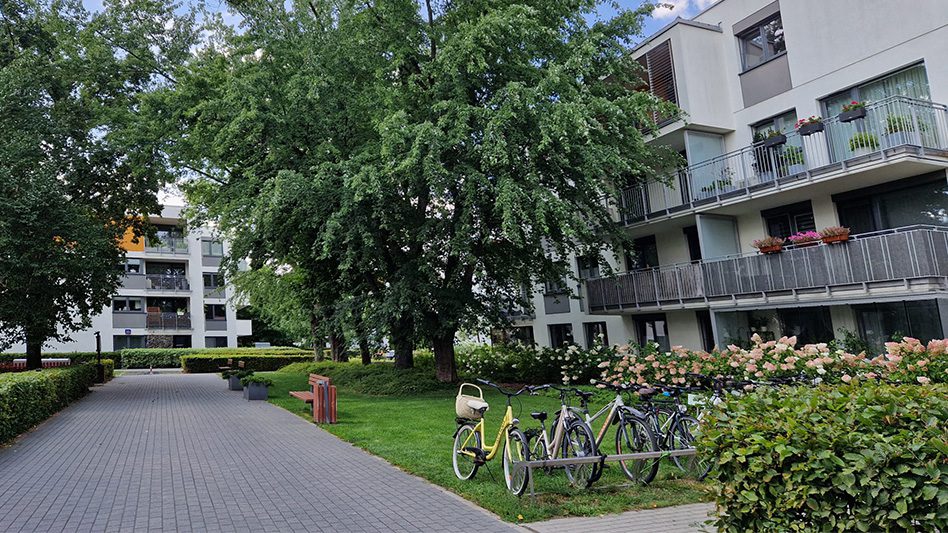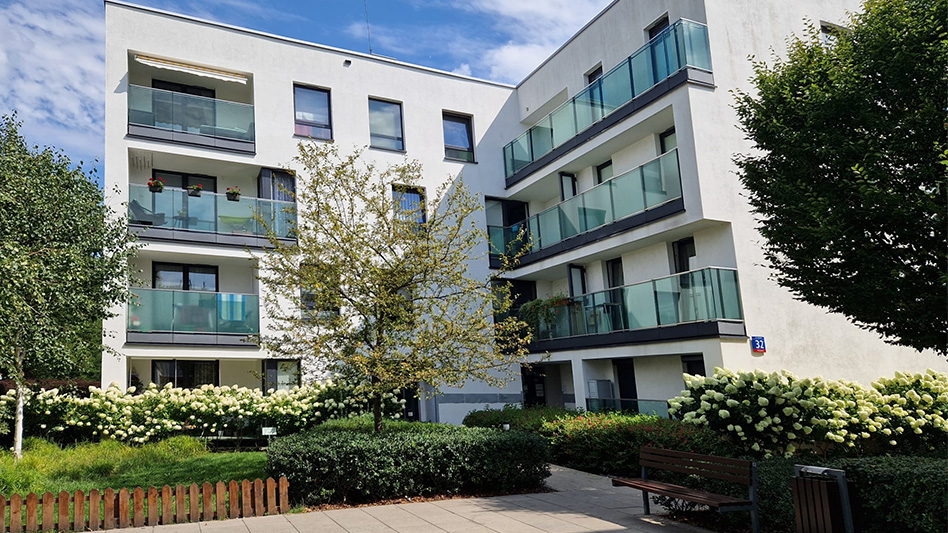This is an article in our Summer 2024 series featuring lessons from abroad. Read also about Vienna.
“Residents are ultimately legally responsible for the maintenance, care and protection of green spaces in residential complexes,” he says. Planner Jolanta Pawlakformer head of the Department of Spatial Planning in Warsaw and trainer of urban climate adaptation strategies for 44 municipalities in Poland.
In practice, Polish housing associations, or homeowners’ associations (HOAs), act on behalf of the residents, Pawlak says. A housing association can also manage a property that does not belong to it, but for which an agreement has been concluded with the owner.
“This often happens in apartment complexes where much of the land between the buildings is owned by the city or state.” The government then formally transfers management to the company.
This concerns, among other things, the territories between residential complexes. In Poland, newly built neighborhoods regularly have a fence with a guard. This does not concern residential areas, but middle-class housing complexes.
Garden maintenance
The manager acts on behalf of the residents of the complex – members of the housing association or homeowners who form a homeowners’ association. The residents decide on the garden work and the rules for maintaining green spaces in the complex and the manager carries them out or has carried them out.

“Residents also jointly determine the maintenance plan and appropriate budgets,” says Pawlak. All residents bear the costs of maintaining the green spaces, such as care, supplementation, planting new plants, fertilization and watering.
For semi-public spaces around the complex, permission from the Board of Directors and the Neighborhood Council is not only required. Active residents should also consult a green expert.
These are not the only rules, says Pawlak. Experts have set standards that green spaces must meet. These relate to aesthetics, cleanliness and sustainability, but also to rainwater retention, climate adaptation and biodiversity protection.
Biomes
Examples include biodiversity areas, which are small areas or sections of parks or other green spaces that have been set aside to protect biodiversity and wildlife. “Another example is ‘fourth nature’, urban wastelands where humans do not interfere and nature can take its course.”
These standards — and each city has its own rules — prevent conflicts within homeowners’ associations or tenant organizations, Pawlak says. The green space manager often plays a key role in resolving disputes, according to the plan.
The downside to this approach, says Pawlak, is that residents have to bear high costs. “The wishes of residents also regularly conflict with the location of infrastructure, such as water or sewage networks and central heating systems.”
In the Polish capital, Green Management Warsaw (ZZW) is responsible for 32 parks, 31 public gardens and countless green areas. In addition, ZZW manages more than 1,300 hectares of green spaces along regional, provincial and national roads, streets and other green areas.
What makes the situation even more complicated are local zoning and building laws and property status. National laws are also sometimes unclear, Pawlak says. “In Polish regulations there are different definitions of green areas, which causes problems in their planning and maintenance.”
Allocations and citizens’ budgets
Pawlak says that green participation in Poland goes beyond the land surrounding buildings and neighborhoods. “Increasingly, residents are helping to create and maintain green spaces on city- or state-owned sites.”

Groenbeheer Warsaw (ZZW) is responsible for the management of public green areas on municipal or state land and is open to bottom-up neighbourhood initiatives by residents. “They arrange, create flower beds, borders and vegetable gardens, plant flower beds in neglected lawns, plant trees and shrubs, and tend these areas.”
“Residents can request to build community gardens,” Pawlak says. “Then the initiators get a plot of land where they can grow vegetables, flowers and herbs for a small fee.” Tools are shared and the administrator handles the day-to-day operations. Pawlak says these types of allotments are becoming increasingly popular in larger cities.
Warsaw City Council, through the “Lush Warsaw programme”, helps entrepreneurs with knowledge and practical issues for working in their “green space”. For example, the city published a guide “How to create a community garden” and the authorities connected entrepreneurs with experts.
The residents’ organization “ADaSie” has neglected Krakow’s green spaces in cities, including the creation of Krakow Parks, where parents plant a tree to commemorate the birth of their children.
Another way Polish cities give influence to citizens is through the citizen budget. Residents help decide on the city’s public spending for the next financial year. “Urban green spaces are one of the most popular topics.”
According to Pawlak, the participation laws are intended to revitalize neighborhoods. “Another important benefit is the responsibility that residents take towards their environment and the quality of urban space,” Pawlak says.
This can be seen in many newly built neighbourhoods in Poland: the green spaces are beautiful, the playgrounds are clean and well maintained. An added advantage is the financial resources, says Pawlak: “These citizen initiatives are often much cheaper than traditional green management solutions.”

“Coffee buff. Twitter fanatic. Tv practitioner. Social media advocate. Pop culture ninja.”











More Stories
Which can cause an increase in nitrogen.
The Central State Real Estate Agency has no additional space to accommodate Ukrainians.
The oystercatcher, the “unlucky national bird,” is increasingly breeding on rooftops.